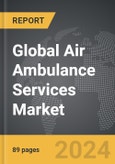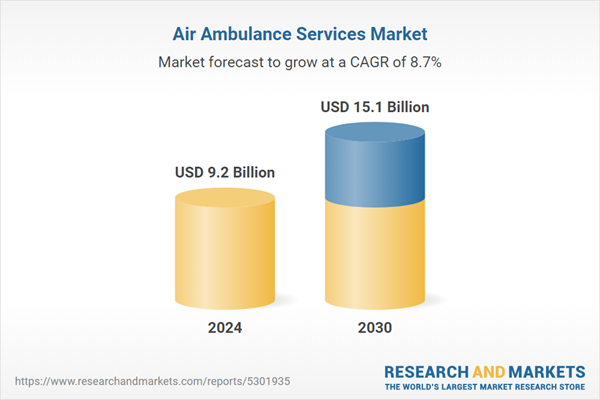The global market for Air Ambulance Services was valued at US$9.2 Billion in 2024 and is projected to reach US$15.1 Billion by 2030, growing at a CAGR of 8.7% from 2024 to 2030. This comprehensive report provides an in-depth analysis of market trends, drivers, and forecasts, helping you make informed business decisions. The report includes the most recent global tariff developments and how they impact the Air Ambulance Services market.
Segments: Type (Rotary-Wing, Fixed-Wing); Service Model (Independent, Hospital-based, Government).
Geographic Regions/Countries: World; United States; Canada; Japan; China; Europe (France; Germany; Italy; United Kingdom; Spain; Russia; and Rest of Europe); Asia-Pacific (Australia; India; South Korea; and Rest of Asia-Pacific); Latin America (Argentina; Brazil; Mexico; and Rest of Latin America); Middle East (Iran; Israel; Saudi Arabia; United Arab Emirates; and Rest of Middle East); and Africa.
The analysts continuously track trade developments worldwide, drawing insights from leading global economists and over 200 industry and policy institutions, including think tanks, trade organizations, and national economic advisory bodies. This intelligence is integrated into forecasting models to provide timely, data-driven analysis of emerging risks and opportunities.
Global Air Ambulance Services Market - Key Trends and Drivers Summarized
How Are Air Ambulance Services Revolutionizing Emergency Medical Care?
Air ambulance services are transforming emergency medical care by providing rapid, life-saving transportation for patients in critical condition or in remote locations where ground ambulances cannot easily reach. These services use helicopters and fixed-wing aircraft equipped with advanced medical equipment and staffed by highly trained medical personnel, allowing for the rapid stabilization and transport of patients to hospitals or trauma centers. The speed at which air ambulances can operate is particularly vital in cases where time is of the essence, such as after severe trauma, strokes, heart attacks, or when patients need to be airlifted from remote or disaster-stricken areas. By reducing transport times and providing critical care en route, air ambulance services improve survival rates and the quality of emergency medical treatment. These services are not limited to national use but are also critical for international patient transport, allowing for medical repatriation or the transfer of patients to specialized facilities in different countries. As healthcare continues to modernize and specialize, the role of air ambulance services in the medical ecosystem is becoming increasingly indispensable.Why Are Air Ambulance Services Critical for Remote and Rural Healthcare?
Air ambulance services play a crucial role in providing healthcare access to individuals living in remote or rural areas, where medical facilities are often far away, and ground transportation may be slow or impractical. In many rural regions, healthcare infrastructure can be limited, with hospitals or specialized care centers located hundreds of miles away. For patients in need of urgent care, particularly those experiencing life-threatening conditions such as heart attacks, strokes, or severe trauma from accidents, the time it takes to reach a medical facility can mean the difference between life and death. Air ambulances provide a fast and efficient solution, dramatically reducing transport times and ensuring that patients can receive advanced medical care as quickly as possible. Helicopters, for instance, can land in areas with limited infrastructure, such as mountainous regions, islands, or remote farms, and provide immediate medical interventions while en route to a hospital. Additionally, air ambulances are crucial during natural disasters, where road access may be blocked, and patients need to be evacuated quickly. In these scenarios, air ambulances act as a lifeline, providing essential medical transport and care when conventional ground services are not feasible.How Is Technology Enhancing the Capabilities of Air Ambulance Services?
Technological advancements have significantly enhanced the capabilities of air ambulance services, making them more efficient, safer, and better equipped to provide critical care during transport. One of the key technological improvements is the integration of advanced medical equipment aboard aircraft, turning air ambulances into fully functioning mobile intensive care units (ICUs). Modern air ambulances are equipped with ventilators, defibrillators, advanced cardiac monitors, and other life-saving tools that enable medical crews to stabilize patients and manage complex conditions during flight. Additionally, advancements in telemedicine allow onboard medical teams to consult with specialists in real time, ensuring that patients receive the best possible care even before they reach a hospital. GPS and satellite navigation systems have also improved the operational efficiency of air ambulance services, enabling pilots to take the fastest and safest routes to hospitals or trauma centers, even in difficult weather conditions or at night. These systems also allow dispatch centers to track air ambulances in real time, optimizing response times and coordinating with ground teams for seamless patient transfers. Moreover, the development of quieter, more fuel-efficient aircraft has expanded the range and capacity of air ambulance services, making long-distance medical transport more accessible and reducing operational costs. These technological innovations are making air ambulance services more reliable, effective, and capable of meeting the growing demand for rapid emergency medical transport.What Factors Are Driving the Growth of the Air Ambulance Services Market?
The growth in the air ambulance services market is driven by several factors, including rising healthcare costs, increasing demand for emergency medical services, and advancements in medical and aviation technology. One of the primary drivers is the growing awareness of the importance of timely medical intervention in critical cases. As populations age and the incidence of chronic conditions such as heart disease, stroke, and trauma increases, the need for rapid emergency medical transport has intensified. Air ambulance services provide a solution by reducing the time it takes for patients to reach hospitals, particularly in emergencies where every minute counts. Additionally, the expansion of healthcare infrastructure in remote and rural areas has created a need for air ambulances to bridge the gap between patients and specialized medical facilities, driving demand in underserved regions. Technological advancements in aviation and medical equipment have also spurred growth in the market. The development of more advanced aircraft with longer ranges, better fuel efficiency, and improved safety features has made air ambulance services more reliable and accessible. Furthermore, the integration of telemedicine and mobile ICU technologies aboard air ambulances has enhanced the quality of care that patients receive during transport, making air ambulances a preferred option for critical medical transfers. Another significant factor is the rise in medical tourism and the increasing number of international patient transfers, where air ambulances are used for long-distance transport between countries for specialized treatments or medical repatriation. Additionally, favorable government policies and reimbursement models in several countries are supporting the growth of air ambulance services by ensuring that patients and healthcare providers have access to these life-saving services without prohibitive costs. Collectively, these factors are driving strong growth in the air ambulance services market, as the demand for fast, efficient, and high-quality medical transport continues to rise.Report Scope
The report analyzes the Air Ambulance Services market, presented in terms of units. The analysis covers the key segments and geographic regions outlined below.Segments: Type (Rotary-Wing, Fixed-Wing); Service Model (Independent, Hospital-based, Government).
Geographic Regions/Countries: World; United States; Canada; Japan; China; Europe (France; Germany; Italy; United Kingdom; Spain; Russia; and Rest of Europe); Asia-Pacific (Australia; India; South Korea; and Rest of Asia-Pacific); Latin America (Argentina; Brazil; Mexico; and Rest of Latin America); Middle East (Iran; Israel; Saudi Arabia; United Arab Emirates; and Rest of Middle East); and Africa.
Key Insights:
- Market Growth: Understand the significant growth trajectory of the Rotary-Wing segment, which is expected to reach US$12.1 Billion by 2030 with a CAGR of a 9.0%. The Fixed-Wing segment is also set to grow at 7.5% CAGR over the analysis period.
- Regional Analysis: Gain insights into the U.S. market, valued at $2.4 Billion in 2024, and China, forecasted to grow at an impressive 12.0% CAGR to reach $3.5 Billion by 2030. Discover growth trends in other key regions, including Japan, Canada, Germany, and the Asia-Pacific.
Why You Should Buy This Report:
- Detailed Market Analysis: Access a thorough analysis of the Global Air Ambulance Services Market, covering all major geographic regions and market segments.
- Competitive Insights: Get an overview of the competitive landscape, including the market presence of major players across different geographies.
- Future Trends and Drivers: Understand the key trends and drivers shaping the future of the Global Air Ambulance Services Market.
- Actionable Insights: Benefit from actionable insights that can help you identify new revenue opportunities and make strategic business decisions.
Key Questions Answered:
- How is the Global Air Ambulance Services Market expected to evolve by 2030?
- What are the main drivers and restraints affecting the market?
- Which market segments will grow the most over the forecast period?
- How will market shares for different regions and segments change by 2030?
- Who are the leading players in the market, and what are their prospects?
Report Features:
- Comprehensive Market Data: Independent analysis of annual sales and market forecasts in US$ Million from 2024 to 2030.
- In-Depth Regional Analysis: Detailed insights into key markets, including the U.S., China, Japan, Canada, Europe, Asia-Pacific, Latin America, Middle East, and Africa.
- Company Profiles: Coverage of players such as Acadian, Air Ambulance Specialists, Air Charter Service, AirMed International, AMR and more.
- Complimentary Updates: Receive free report updates for one year to keep you informed of the latest market developments.
Some of the 34 companies featured in this Air Ambulance Services market report include:
- Acadian
- Air Ambulance Specialists
- Air Charter Service
- AirMed International
- AMR
- Deccan Charters
- Envision Healthcare Companies
- Express AirMed Transport
- Falck Danmark A/S
- IAS Medical
- Lifeguard Air Ambulance
- Native American Air Ambulance
- PHI Air Medical
- REVA Air Ambulance
- Scandinavian Air Ambulance
Tariff Impact Analysis: Key Insights for 2025
Global tariff negotiations across 180+ countries are reshaping supply chains, costs, and competitiveness. This report reflects the latest developments as of April 2025 and incorporates forward-looking insights into the market outlook.The analysts continuously track trade developments worldwide, drawing insights from leading global economists and over 200 industry and policy institutions, including think tanks, trade organizations, and national economic advisory bodies. This intelligence is integrated into forecasting models to provide timely, data-driven analysis of emerging risks and opportunities.
What’s Included in This Edition:
- Tariff-adjusted market forecasts by region and segment
- Analysis of cost and supply chain implications by sourcing and trade exposure
- Strategic insights into geographic shifts
Buyers receive a free July 2025 update with:
- Finalized tariff impacts and new trade agreement effects
- Updated projections reflecting global sourcing and cost shifts
- Expanded country-specific coverage across the industry
Table of Contents
I. METHODOLOGYII. EXECUTIVE SUMMARY2. FOCUS ON SELECT PLAYERSIII. MARKET ANALYSISSOUTH KOREAREST OF ASIA-PACIFICARGENTINABRAZILMEXICOREST OF LATIN AMERICAIRANISRAELSAUDI ARABIAUNITED ARAB EMIRATESREST OF MIDDLE EASTIV. COMPETITION
1. MARKET OVERVIEW
3. MARKET TRENDS & DRIVERS
4. GLOBAL MARKET PERSPECTIVE
UNITED STATES
CANADA
JAPAN
CHINA
EUROPE
FRANCE
GERMANY
ITALY
UNITED KINGDOM
SPAIN
RUSSIA
REST OF EUROPE
ASIA-PACIFIC
AUSTRALIA
INDIA
LATIN AMERICA
MIDDLE EAST
AFRICA
Companies Mentioned (Partial List)
A selection of companies mentioned in this report includes, but is not limited to:
- Acadian
- Air Ambulance Specialists
- Air Charter Service
- AirMed International
- AMR
- Deccan Charters
- Envision Healthcare Companies
- Express AirMed Transport
- Falck Danmark A/S
- IAS Medical
- Lifeguard Air Ambulance
- Native American Air Ambulance
- PHI Air Medical
- REVA Air Ambulance
- Scandinavian Air Ambulance
Table Information
| Report Attribute | Details |
|---|---|
| No. of Pages | 89 |
| Published | April 2025 |
| Forecast Period | 2024 - 2030 |
| Estimated Market Value ( USD | $ 9.2 Billion |
| Forecasted Market Value ( USD | $ 15.1 Billion |
| Compound Annual Growth Rate | 8.7% |
| Regions Covered | Global |









